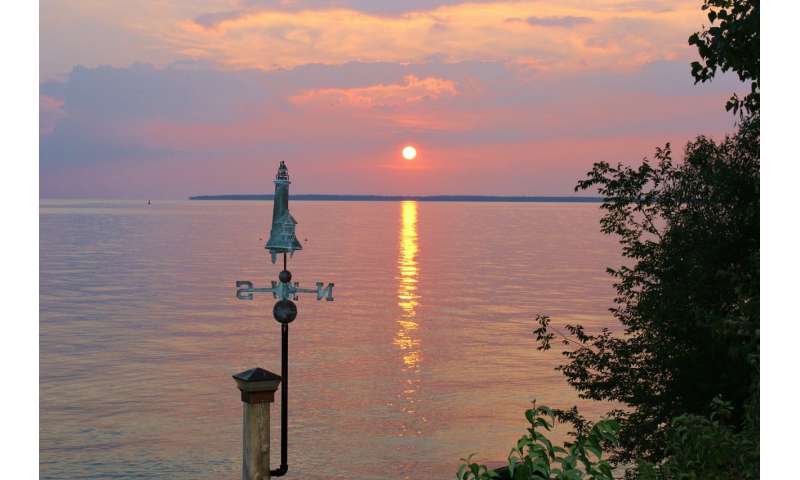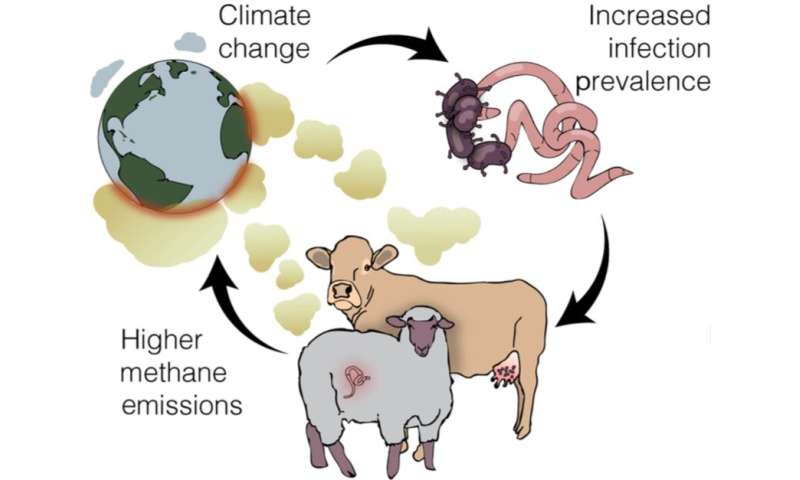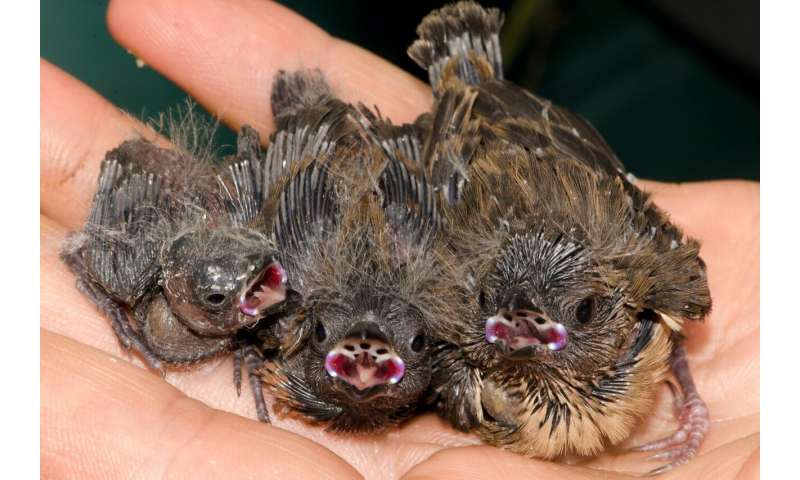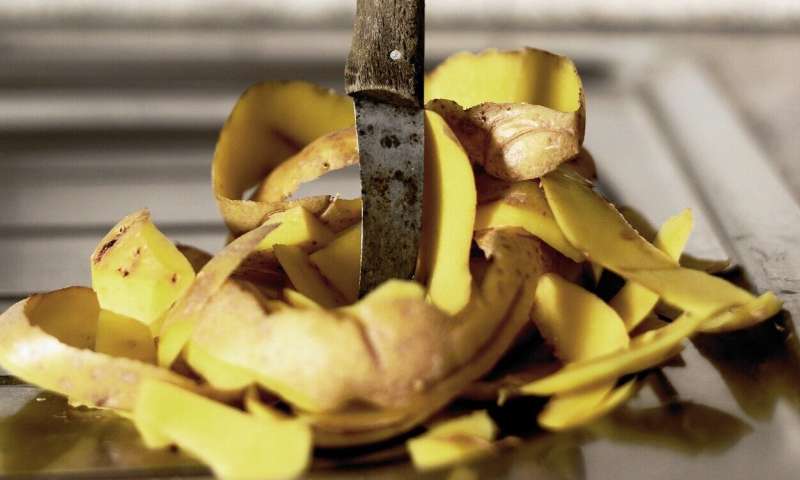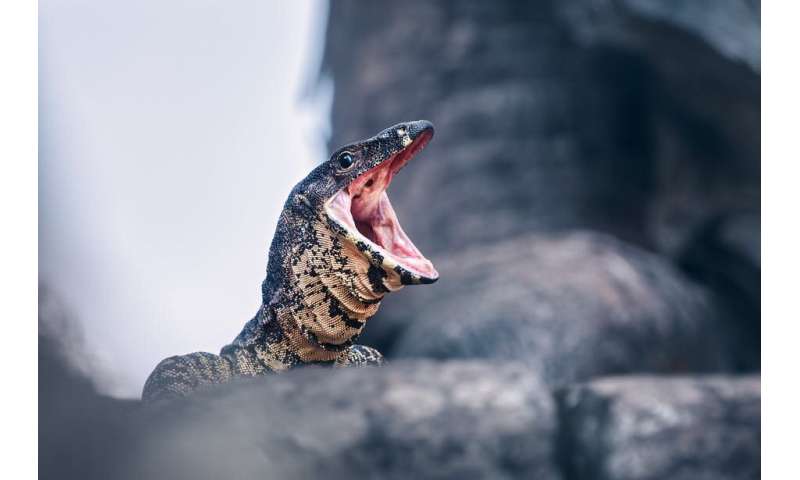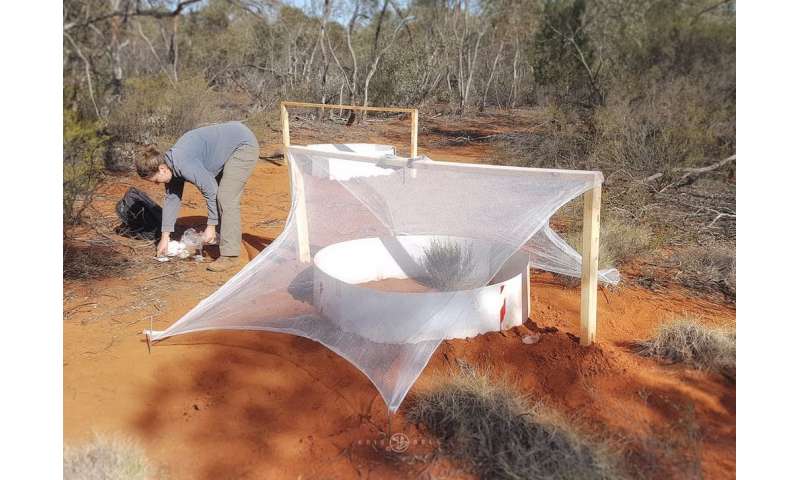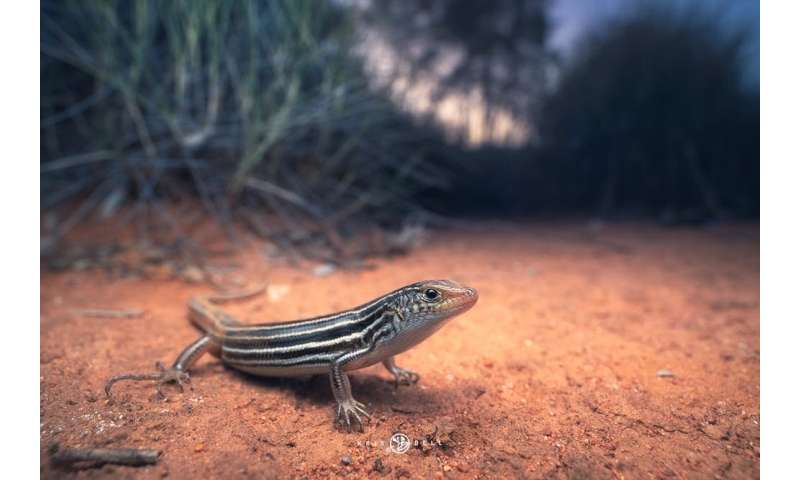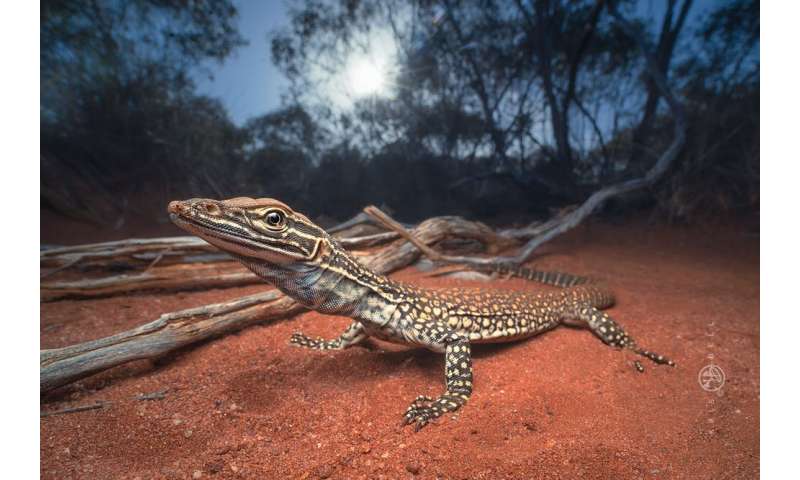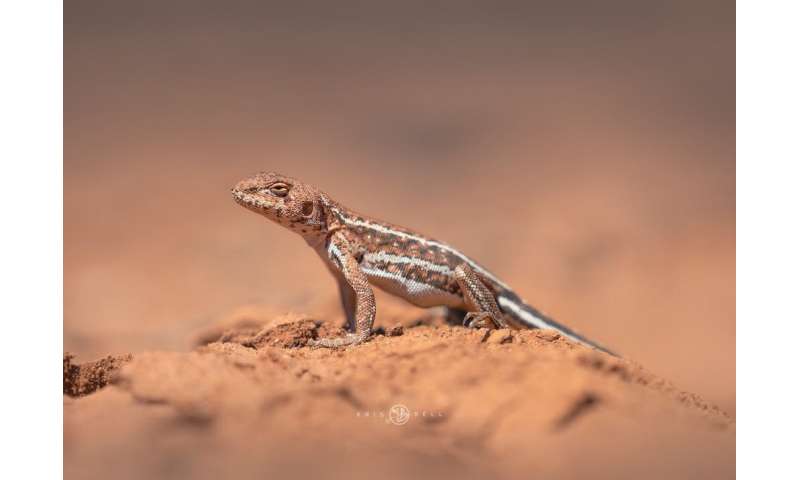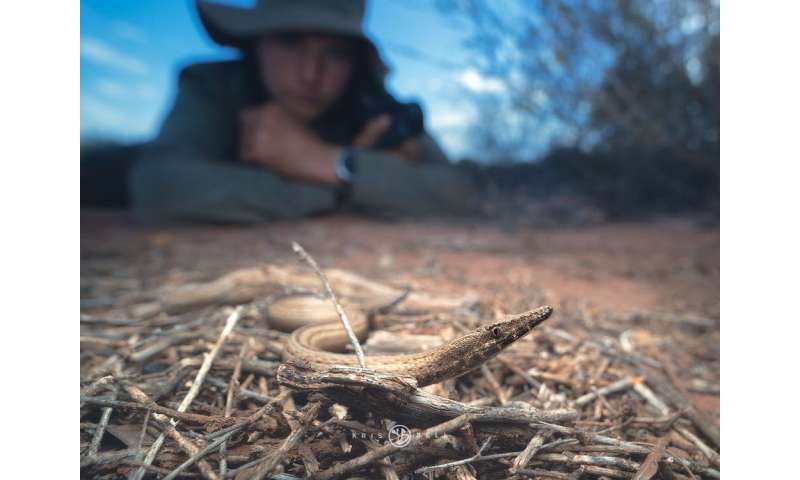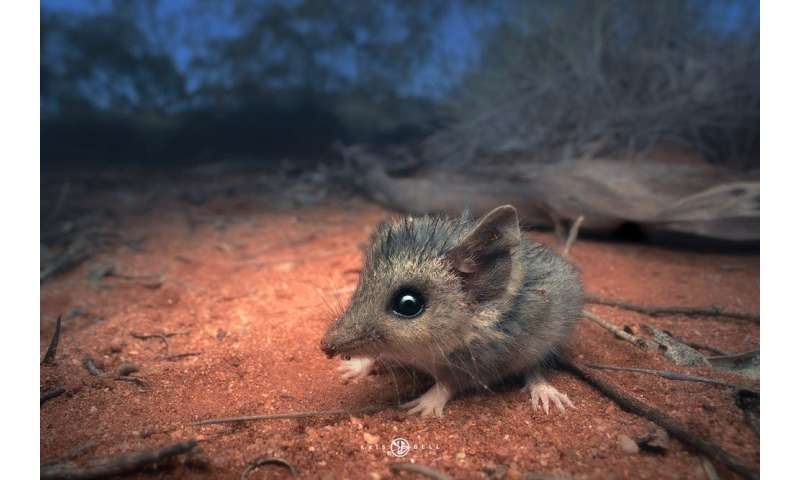Was the moon magnetized by impact plasmas?
by Thamarasee Jeewandara , Phys.org
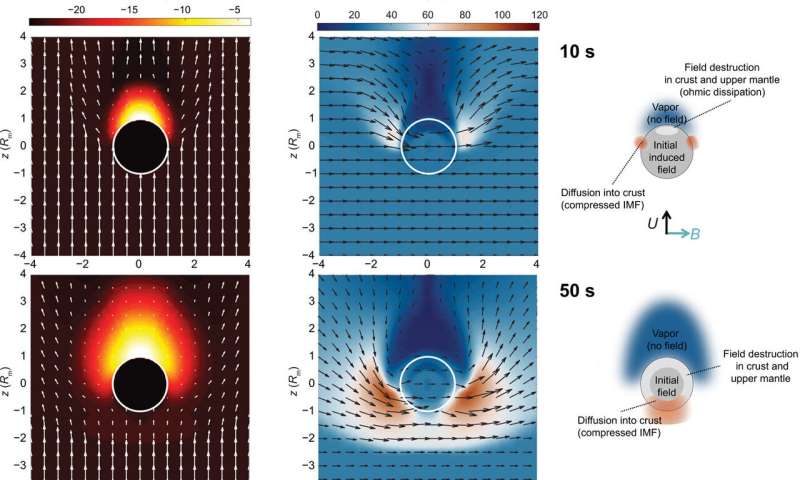
Plasma flow and magnetic field evolution following a basin-forming impact on the Moon. Snapshots are extracted at 10, 50, 150, and 300 s after impact in the plane containing the impact vector (−z direction), solar wind flow (+z direction), and the IMF (+x direction). The impact location is at (x, y, z) = (0, 0, 1) Rm. The left panels show the plasma density (color contours) and velocity (white arrows, scaled to the speed and pointing in flow direction). The middle panels show the magnetic field magnitude (color contours) and vector (black arrows, scaled to magnitude and pointing in field direction). The right panels show diagrams highlighting the factors controlling the field evolution at each snapshot. The arrows marked by U and B are the solar wind velocity and IMF direction, respectively. Credit: Science Advances, doi: 10.1126/sciadv.abb1475
The moon, Mercury and many meteorite parent bodies contain a magnetized crust, which is commonly credited to an ancient core dynamo. A longstanding alternative hypothesis suggests the amplification of the interplanetary magnetic field and induced field of the crust (crustal field) via plasma generated through meteoroid impacts. In a new report now published on Science Advances, Rona Oran and a research team in the Departments of Earth and Planetary Sciences, Geosciences and Space Science in the U.S., Germany and Australia showed that although impact plasmas can transiently enhance the field inside the moon, the resulting fields were at least three orders of magnitude too weak to explain magnetic anomalies of the lunar crust. The team used magnetohydrodynamic and impact simulations alongside analytical relationships in this work to show the core dynamo (and not plasmas generated by asteroid impact) to be the only possible source of magnetization on the moon.
The lunar dynamo and lunar crust
The inductively generated magnetic fields in a fluid planetary interior is generated via the dynamo process. The moon presently lacks a core dynamo magnetic field, but as of the Apollo era, scientists have shown that the lunar crust contained remnant magnetization. According to studies, the magnetizing field likely reached tens of microteslas more than 3.56 billion years ago, however, the origin of the strongest lunar crustal anomalies and their source of magnetization remain long-standing mysteries. Preceding studies imply the existence of a fundamentally different non-convective dynamo mechanism on the moon.
More specifically, the hypervelocity resulting from asteroid impacts can vaporize and ionize lunar crustal materials to directly release plasma into the wind. Since the strongest and largest anomalies of the lunar crust are directly located at the antipodes (geographical sites) of four young large basins, researchers hypothesize impact plasmas to have engulfed the moon and compressed the interplanetary magnetic field (IMF) to cause an enhanced crustal field at the antipode. Oran et al. addressed the existing gaps by introducing self-consistent modeling of post-impact plasmas and magnetic fields to explain field diffusion and dissipation inside the moon—alongside revised analytical considerations. To accomplish this, the team combined shock physics simulations of basin excavation and vapor generation with magnetohydrodynamic (MHD) simulations.
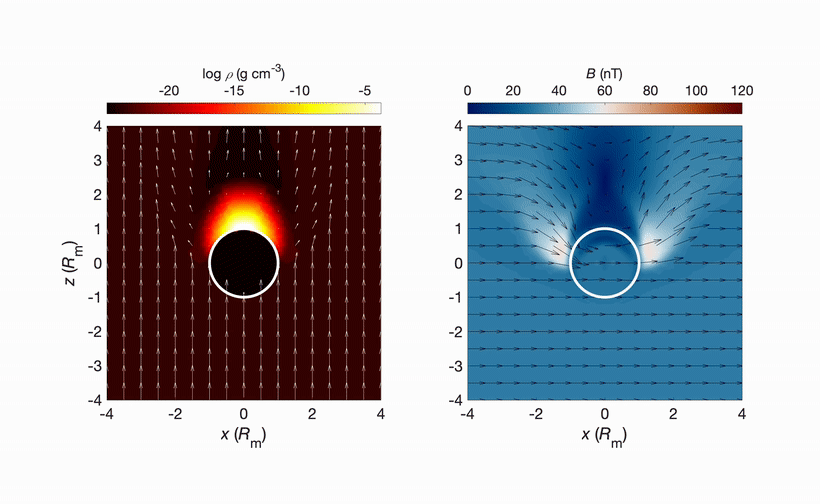
Time-dependent plasma flow and magnetic field evolution following a basin forming impact on the Moon. The movie shows the evolution after the impact described in Case 1 (baseline scenario) in a plane containing the impact vector (–z direction), solar wind flow (+z direction) and the IMF (+x direction). The impact location is at (x, y, z) = (0, 0, 1) Rm. The left panel shows the plasma density (color contours) and velocity (white arrows, scaled to the speed and pointing in flow direction). The right panel shows the magnetic field magnitude (color contours) and vector (black arrows, scaled to magnitude and pointing in field direction). Credit: Science Advances,
doi: 10.1126/sciadv.abb1475Simulating the Imbrium basin
The scientists used the shock physics code iSALE-2-D to perform impact basin-forming simulations, a multimaterial, multirheology code in two dimensions (2-D). They also drove 3-D MHD (magnetohydrodynamic) simulations including the interaction of the moon, the solar wind and the vapor. During MHD simulations, Oran et al. used the Block Adaptive Tree Solar-Wind Roe Upwind Scheme (abbreviated BATS-R-US) code, capable of modeling the magnetic field evolution inside resistive bodies. They then focused on the Imbrium basin of the moon—also known as the right eye of the fabled man in the moon; formed via an asteroid or protoplanet collision. The antipodal region of the Imbrium currently contains some of the strongest magnetic anomalies observed from orbit. They simulated the impactor-based basin formation method, including vapor generation and basin excavation. The expanding impact plasma of the simulation created a magnetic cavity and enhanced the interplanetary magnetic field (IMF) at its periphery, causing the IMF carried by the wind to pile up against the vapor.
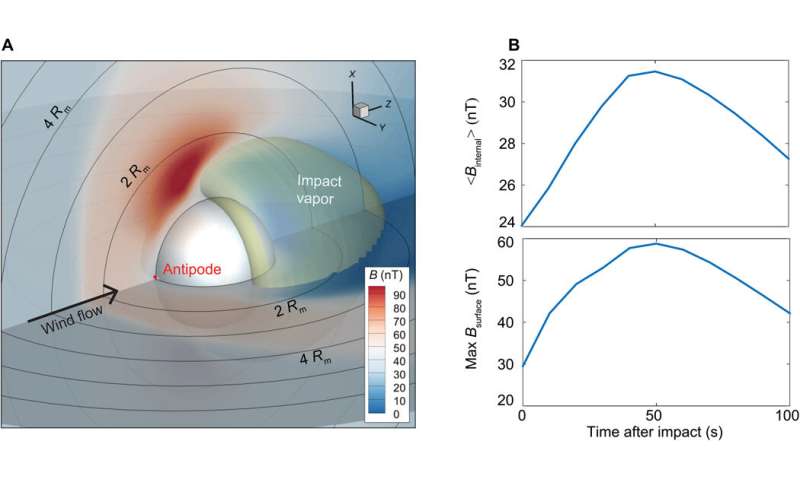
Magnetic field at the time of maximum field for the simulation. (A) 3-D view at 50 s after impact. The spherical surface at the center is the lunar surface. The transparent yellow surface is an iso-surface of density of 107 cm−3, approximating the shape of the cloud periphery. The color contours show the magnetic field on the lunar surface and in the x-z and y-z planes, and the black contours show the Moon-centric distance in lunar radii, Rm. The point of view was chosen to overlook the area antipodal to the impact (red cross). (B) Magnetic field as a function of time. (Top) Mean field inside the Moon as a function of time. (Bottom) Maximum field found inside the crust (upper 5% of radius of Moon) as a function of time. Credit: Science Advances, doi: 10.1126/sciadv.abb1475
Studying the parameter space of different impact scenarios
At first, the moon's resistive outer layers destroyed the magnetic flux at a rate comparable to the rate of vapor expansion. This rate of loss of the magnetic field was consistent with theoretical estimations that contributed to remove magnetic energy from the system. The 3-D diffusion of the field in the mantel and crust allowed the field to slip around the core instead of being anchored within. The results did not indicate the conservation of magnetic energy or field convergence. The work further indicated that plasma amplified fields cannot account for crustal magnetization and the strongest amplification occurred far above the surface of the moon. An additional mechanism that could have limited the antipodal effect was magnetic reconnection, although the phenomenon did not occur due to the absence of antiparallel field geometry. Any magnetic flux pushed toward the antipode either dissipated inside the moon or was advected away by vapor.
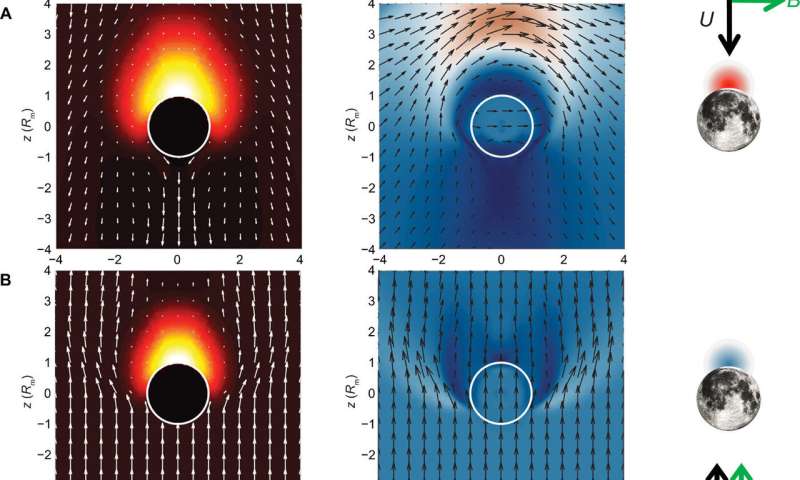
Plasma flow and magnetic field evolution following four different impact scenarios (cases 2, 4, 6, and 7). Snapshots from 50 s after launch of the vapor into the MHD simulations (table S1) are shown. The right column depicts the initial conditions, where U and B are the solar wind velocity and IMF direction, respectively. (A) Impact on upwind side (case 2). (B) IMF parallel to that of the solar wind flow (case 4). (C) Lunar crust and mantle with enhanced conductivities (case 6). (D) Colder vapor and faster wind (case 7). Credit: Science Advances, doi: 10.1126/sciadv.abb1475
Oran et al. simulated seven additional choices for IMF (interplanetary magnetic field) detection including solar wind speed, impact location and impact cloud physical properties, with different combinations of parameters. They used several cases to explore alternative impact locations and relative orientations of the IMF and solar wind velocity. The largest overall amplification in the crest occurred in cases where the impact location and relative orientation of the IMF and solar wind velocity were similar.
Field enhancement due to vapor expansion into the solar wind
The MHD (magnetohydrodynamic) simulations showed how vapor expansion enhanced the interplanetary magnetic field (IMF) carried by the solar wind, presenting an obstacle to the wind, and causing de-acceleration and piling up. The source of the compressed IMF magnetic energy contained bulk kinetic energy of the upstream wind and the level of amplification was consistent with pile-up regions on comets and the ionosphere of Venus, while lower than the IMF compression ratio estimated for impact plasmas on the moon. The team also found the resistivity of the crust to be the main factor inhibiting magnetic field enhancement inside the moon. The magnetic field evolution occurred on a complex structure as reflected in the simulations, leading to the removal of flux from the crust and upper mantle, where the moon crust effectively reduced the magnetic energy on exposure to a magnetic cavity. This unexpected outcome was due to vapor expansion that occurred after impact, causing the incoming interplanetary magnetic field to change direction and gradually magnetically isolate the moon from the interplanetary magnetic field.
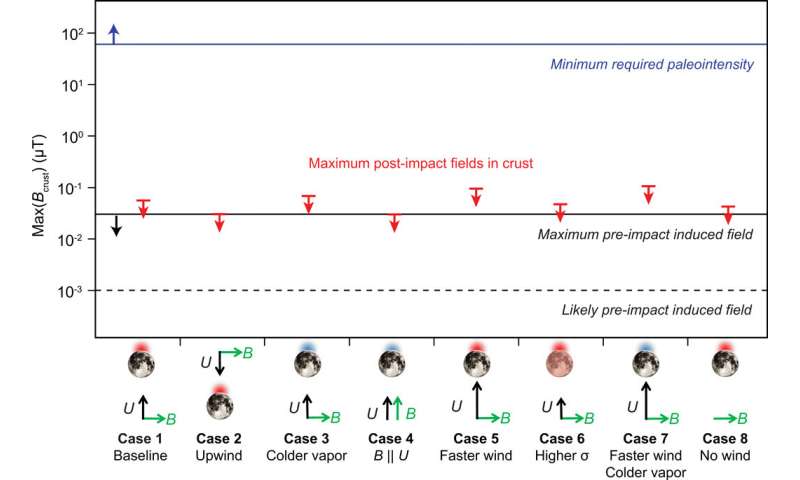
The maximum predicted crustal amplified field compared to the paleointensities of the fields that magnetized the Moon. Red arrows mark the maximum enhanced fields for each of the eight simulation cases, each of which differs by one or two parameters from the baseline (case 1). From left to right, these are baseline simulation (case 1), impact location on upwind side of Moon (case 2), colder impact vapor (case 3), IMF parallel to solar wind velocity (case 4), faster solar wind (case 5), higher conductivity of crust and mantle (case 6), faster solar wind and colder impact vapor (case 7), and no solar wind flow (case 8). The blue solid line marks the minimum required paleointensities. The black solid line marks the initial induced internal field used in the simulations (30 nT; an extreme upper limit). The black dashed line marks the more plausible initial value (1 nT) based on the vector mean of a realistic IMF at 3.9 Ga ago. Credit: Science Advances, doi: 10.1126/sciadv.abb1475
The impact-amplified magnetic field hypothesis is a leading alternative to a core dynamo origin of crustal magnetization in the moon and other interplanetary bodies. However, this work showed how such fields are too weak to explain the strong lunar crustal anomalies and paleointensities of Apollo samples. Oran et al. therefore support the proposal of lunar paleomagnetism as a record of dynamo action on the moon. Impact plasmas may still be a viable mechanism to magnetize some regions of the crust if they are formed in the presence of a pre-existing core-dynamo field on the moon, such interactions remain to be further investigated with magnetohydrodynamic simulations.
Explore further







